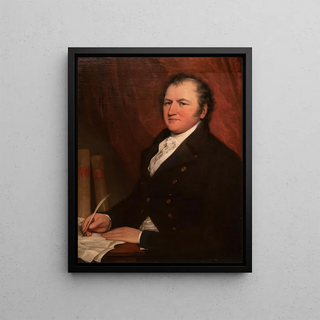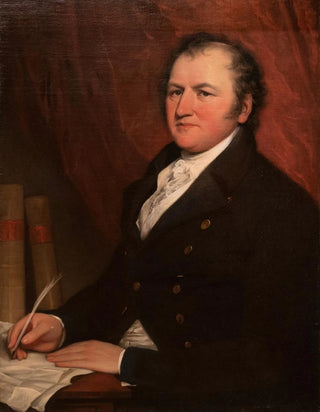Art print | Robert Lenox 1759–1839 - John Trumbull


View from behind

Frame (optional)
Robert Lenox 1759–1839 art print - John Trumbull – Engaging introduction
In the rich and complex universe of art history, certain works stand out for their ability to capture not only faces but also eras and stories. The Robert Lenox 1759–1839 art print - John Trumbull is a perfect example. This iconic portrait, created by the talented John Trumbull, transports us to the heart of 19th-century America, a period marked by social and political upheavals. Through Lenox's penetrating gaze, Trumbull succeeds in immortalizing the very essence of a man who played a significant role in his time's history, while offering a reflection on the emerging identity and patriotism of the United States.
Style and uniqueness of the work
Trumbull's style is characterized by remarkable meticulousness and particular attention to detail. In this portrait, he manages to blend realism and idealization, bringing Robert Lenox to life while maintaining a certain distance that invites contemplation. The color palette chosen by the artist evokes an atmosphere that is both solemn and warm, reinforcing the character of the subject. The drapery of Lenox, carefully depicted, testifies to Trumbull's technical expertise, while the subtly orchestrated lighting accentuates the figure's face, revealing rare psychological depth. This work does not merely depict a man; it tells a story, that of a time and place, while elevating the portrait to a level of narrative art.
The artist and his influence
John Trumbull, often considered the painter of the American Revolution, knew how to mark his era with his ability to translate historical events into poignant images. His training with the great European masters allowed him to develop a unique style that combines academic rigor with a sensitivity characteristic of emerging American art. Trumbull not only painted iconic figures of his time but also played a crucial role in the visual documentation of American history. His influence endures today, not only through his works but also through the way he inspired generations of artists to explore and depict national identity.

Matte finish

View from behind

Frame (optional)
Robert Lenox 1759–1839 art print - John Trumbull – Engaging introduction
In the rich and complex universe of art history, certain works stand out for their ability to capture not only faces but also eras and stories. The Robert Lenox 1759–1839 art print - John Trumbull is a perfect example. This iconic portrait, created by the talented John Trumbull, transports us to the heart of 19th-century America, a period marked by social and political upheavals. Through Lenox's penetrating gaze, Trumbull succeeds in immortalizing the very essence of a man who played a significant role in his time's history, while offering a reflection on the emerging identity and patriotism of the United States.
Style and uniqueness of the work
Trumbull's style is characterized by remarkable meticulousness and particular attention to detail. In this portrait, he manages to blend realism and idealization, bringing Robert Lenox to life while maintaining a certain distance that invites contemplation. The color palette chosen by the artist evokes an atmosphere that is both solemn and warm, reinforcing the character of the subject. The drapery of Lenox, carefully depicted, testifies to Trumbull's technical expertise, while the subtly orchestrated lighting accentuates the figure's face, revealing rare psychological depth. This work does not merely depict a man; it tells a story, that of a time and place, while elevating the portrait to a level of narrative art.
The artist and his influence
John Trumbull, often considered the painter of the American Revolution, knew how to mark his era with his ability to translate historical events into poignant images. His training with the great European masters allowed him to develop a unique style that combines academic rigor with a sensitivity characteristic of emerging American art. Trumbull not only painted iconic figures of his time but also played a crucial role in the visual documentation of American history. His influence endures today, not only through his works but also through the way he inspired generations of artists to explore and depict national identity.






